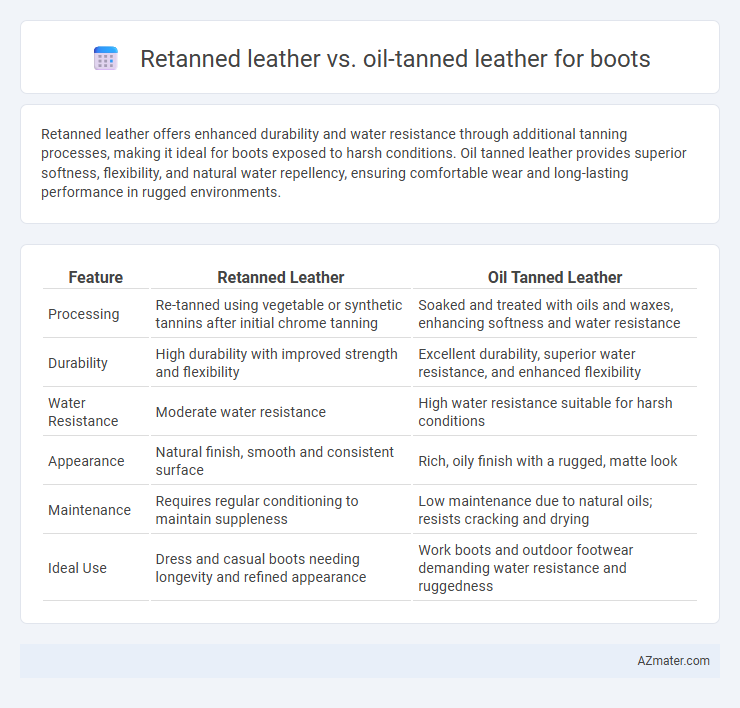Retanned leather offers enhanced durability and water resistance through additional tanning processes, making it ideal for boots exposed to harsh conditions. Oil tanned leather provides superior softness, flexibility, and natural water repellency, ensuring comfortable wear and long-lasting performance in rugged environments.
Table of Comparison
| Feature | Retanned Leather | Oil Tanned Leather |
|---|---|---|
| Processing | Re-tanned using vegetable or synthetic tannins after initial chrome tanning | Soaked and treated with oils and waxes, enhancing softness and water resistance |
| Durability | High durability with improved strength and flexibility | Excellent durability, superior water resistance, and enhanced flexibility |
| Water Resistance | Moderate water resistance | High water resistance suitable for harsh conditions |
| Appearance | Natural finish, smooth and consistent surface | Rich, oily finish with a rugged, matte look |
| Maintenance | Requires regular conditioning to maintain suppleness | Low maintenance due to natural oils; resists cracking and drying |
| Ideal Use | Dress and casual boots needing longevity and refined appearance | Work boots and outdoor footwear demanding water resistance and ruggedness |
Introduction to Retanned and Oil Tanned Leather
Retanned leather is crafted by subjecting initially tanned hides to additional tanning processes, enhancing durability, flexibility, and resistance to wear, ideal for sturdy boots. Oil tanned leather involves saturating the hide with natural oils, resulting in a water-resistant, soft, and supple material favored for comfortable and rugged footwear. Both processes influence boot performance by varying moisture resistance, texture, and longevity tailored to specific usage needs.
What is Retanned Leather?
Retanned leather for boots undergoes a secondary tanning process using various tanning agents to enhance durability, softness, and color retention. This method improves the leather's resistance to water and wear compared to single-tanned leather, making it suitable for high-quality footwear. Oil tanned leather, in contrast, is treated with oils to increase flexibility and water resistance but may sacrifice some structural strength found in retanned leather.
What is Oil Tanned Leather?
Oil tanned leather is a type of leather treated with oils and waxes during the tanning process, making it highly water-resistant, flexible, and durable, ideal for rugged boot use. Unlike retanned leather, which undergoes additional tanning to improve softness and strength, oil tanned leather retains its natural oils, giving it a distinctive rich color and a supple yet tough texture. This treatment enhances the leather's ability to withstand harsh conditions, making oil tanned leather boots popular for outdoor activities and heavy-duty work environments.
Key Differences: Retanned vs Oil Tanned Leather
Retanned leather undergoes a secondary tanning process that enhances durability, softness, and flexibility, making it ideal for high-quality boots requiring breathability and long-term wear. Oil tanned leather is impregnated with oils during tanning, resulting in water-resistant, robust material with a distinct oily finish suited for rugged, outdoor boots. Key differences lie in texture, water resistance, and maintenance, with retanned leather offering a smoother feel and oil tanned leather excelling in weatherproofing and hardness.
Durability Comparison for Boots
Retanned leather undergoes a secondary tanning process that enhances fiber bonding, resulting in increased durability and resistance to wear, making it ideal for heavy-duty boots. Oil tanned leather is deeply saturated with oils, providing superior water resistance and flexibility but may show quicker surface wear under abrasive conditions. For long-lasting boots exposed to rugged environments, retanned leather generally offers better structural integrity, while oil tanned leather excels in maintaining softness and moisture protection.
Water Resistance and Weather Performance
Retanned leather offers enhanced water resistance due to additional tanning processes that stabilize the leather fibers, making it less prone to water absorption and suitable for wet conditions. Oil tanned leather excels in weather performance by incorporating natural oils that create a flexible, water-repellent surface, ensuring durability in harsh and variable climates. Both types provide robust protection, but oil tanned leather typically performs better in consistently wet or muddy environments, while retanned leather balances water resistance with structural strength for longer-lasting boots.
Comfort and Feel Over Time
Retanned leather offers a firmer texture initially but softens with extended wear, molding closely to the foot for increased comfort over time. Oil tanned leather provides a supple, flexible feel from the start, maintaining water resistance while developing a rich patina that enhances softness. Both types improve comfort through aging, but oil tanned leather generally delivers quicker adaptability and a smoother touch during prolonged use.
Maintenance and Care Requirements
Retanned leather boots require regular cleaning with a damp cloth and conditioning every few months to maintain flexibility and prevent cracking, while oil tanned leather boots need more frequent application of oil-based conditioners to preserve their water resistance and suppleness. Retanned leather is more breathable but less resistant to water damage, demanding prompt drying after exposure to moisture, unlike oil tanned leather which naturally repels water and dirt. Proper maintenance for both types involves avoiding excessive heat and using appropriate products designed for each leather's specific tanning process to extend boot lifespan.
Best Uses for Each Leather Type in Boots
Retanned leather offers enhanced durability and water resistance, making it ideal for hiking or work boots that endure heavy wear and exposure to elements. Oil tanned leather provides superior flexibility and softness, perfect for casual or fashion boots requiring comfort and a sleek appearance. Each leather type supports specific boot functions, with retanned best suited for rugged outdoor activities and oil tanned for style and everyday wear.
Choosing the Right Leather for Your Boots
Retanned leather offers enhanced durability and water resistance, making it ideal for boots intended for rugged outdoor use. Oil tanned leather provides superior flexibility and a rich, soft texture, perfect for boots requiring comfortable wear and a vintage aesthetic. Choosing the right leather depends on whether durability and weather protection or comfort and style are the primary priorities for your boots.

Infographic: Retanned leather vs Oil tanned leather for Boot
 azmater.com
azmater.com